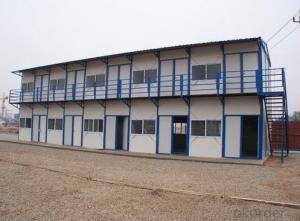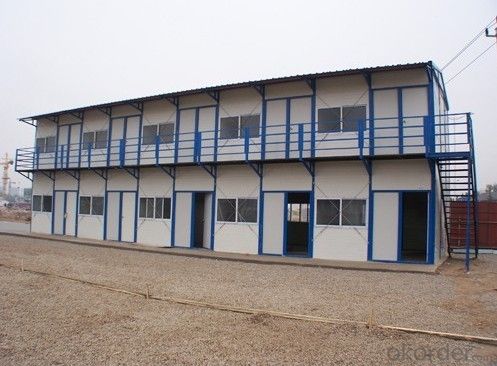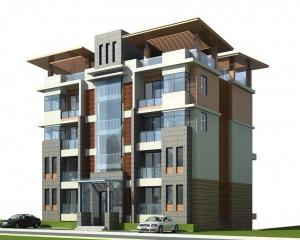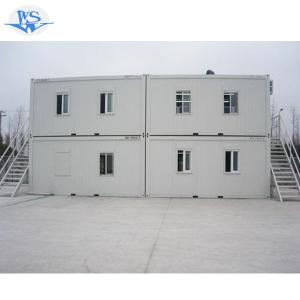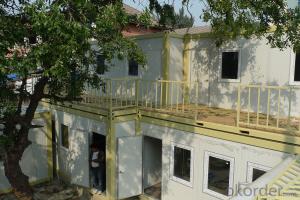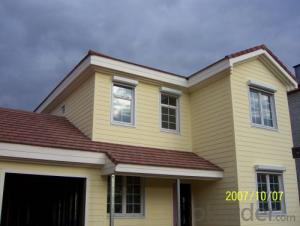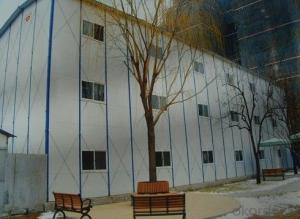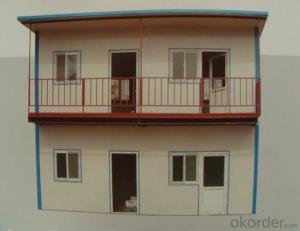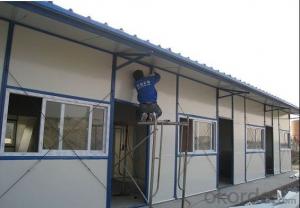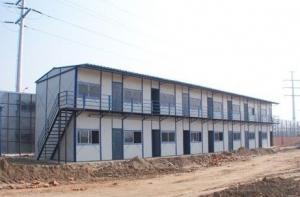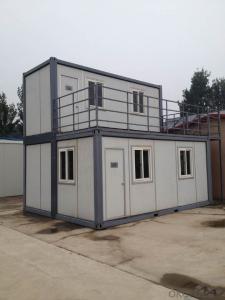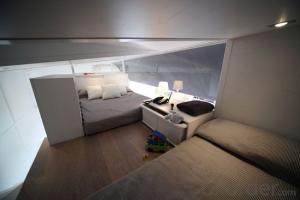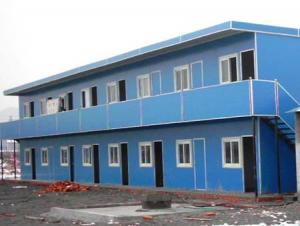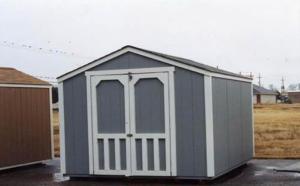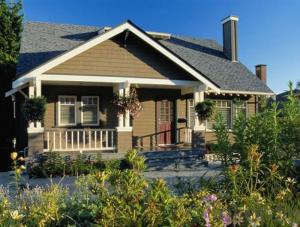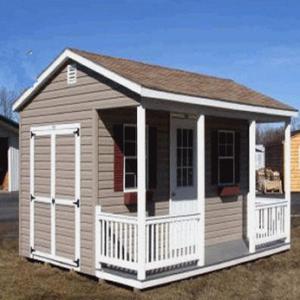Double prefabricated houses, sandwich panels mobile homes
OKorder Service Pledge
OKorder Financial Service
You Might Also Like
Packaging & Delivery
| Packaging Detail: | Bulk packages, 100m2/20'GP, 240m2/40'HQ |
| Delivery Detail: | 15-20 work days |
Specifications
Decoration house:
1.Area: 40-200m2
2.Size and plan are customized
3.Multi-layer is available
4.Turn-Key house is available
Product information:
Structure: light steel structure
Wall: 50mm/75mm/100mm/150mm color steel sandwich panel, white panel or pattern panel
Roof:color steel tile/sandwich corrugated roof panel, glazed tile
Window:UPVC or aluminum window
Door:SIP door, compound wooden door, security steel door etc
Ceiling:calcium silicate ceiling, PVC ceiling or sandwich panel
Accessories: rivet, screw, glue, etc
Veranda, Garage and fence can be customized as required.
Feature:
(1). Waterproof and sound insulation
(2). Thermal and heat insulation
(3). Low demand of ground work
(4). Particular panel with variety of pattern. To use directly, no need decoration.
(5). Multi layer is available
Application:
Makeshift dwellings, living house, dorm, hotel, office, hospital and so on.
Customized design is welcome.
Also, we provide turn-key house solution, offer pumping work, electrical system, sanitary fittings, kitchen system, and decoration work.
- Q: Can container houses be designed with a fireplace?
- Yes, container houses can definitely be designed with a fireplace. While the small size and unconventional structure of container houses may present some challenges, it is entirely possible to incorporate a fireplace into the design. There are a few considerations that need to be taken into account when designing a container house with a fireplace. Firstly, the weight of the fireplace and chimney must be factored in to ensure the structural integrity of the container. Reinforcements may need to be made to the walls or foundation to support the added weight. Secondly, the ventilation and safety aspects of a fireplace need to be carefully planned. Adequate ventilation must be provided to ensure proper air circulation and prevent the accumulation of smoke or carbon monoxide. Additionally, fire-resistant materials and insulation should be used to protect the container from potential fire hazards. Lastly, the size and type of fireplace should be chosen wisely to suit the available space and the overall design aesthetic of the container house. Space-saving options like compact wood-burning stoves or electric fireplaces can be considered, depending on the preferences and needs of the homeowner. Overall, while it may require some careful planning and modifications, container houses can indeed be designed with a fireplace, adding warmth and coziness to the living space.
- Q: Are container houses suitable for rental properties?
- Yes, container houses can be suitable for rental properties. They are cost-effective, versatile, and can be easily modified to meet the needs of renters. Container houses offer a unique aesthetic and can be customized to provide comfortable living spaces. Additionally, their portability allows for flexibility in location, making them a viable option for rental properties.
- Q: Are container houses suitable for music studios?
- Indeed, container houses can serve as appropriate settings for music studios. The versatility and cost-effectiveness of these dwellings have contributed to their increasing popularity. They can be easily modified and customized to cater to specific requirements, rendering them ideal for a multitude of purposes, including music studios. Container houses furnish a robust and soundproof environment, a crucial aspect for any music studio. The steel walls of these containers furnish exceptional insulation against external noise, guaranteeing that sounds produced within the studio do not disturb the surroundings, and vice versa. Moreover, containers can be effortlessly equipped with suitable insulation materials, such as acoustic foam panels or soundproof glass, to further enhance the audio quality within the studio. Consequently, musicians and producers can compose and record music without unwanted external noises or disturbances. Furthermore, container houses can be conveniently expanded or combined to create larger studio spaces, accommodating multiple recording rooms, control rooms, and even lounges or waiting areas. This adaptability permits future growth and the capacity to adjust to evolving needs. Container houses also prove cost-effective when compared to conventional construction methods. They are easily accessible, and their modular nature simplifies the construction process, reducing both time and expenses. As a result, musicians and artists with limited budgets can acquire their own professional spaces for music production and recording. All in all, container houses offer a pragmatic and efficient solution for music studios. They bestow soundproofing, flexibility, and cost-effectiveness, rendering them a suitable choice for musicians, producers, and anyone seeking to create a professional music environment.
- Q: Are container houses pest-resistant?
- Container houses can be made to be pest-resistant, but it ultimately depends on the measures taken during construction and ongoing maintenance. Shipping containers are typically made of steel, which pests like termites cannot eat through, offering an advantage over traditional wooden structures. However, pests such as rodents, insects, and mold can still find their way into container houses through small openings or gaps if not properly sealed and insulated. To make container houses pest-resistant, it is important to ensure that all openings, including windows, doors, and ventilation systems, are properly sealed to prevent pests from entering. Insulation should also be installed to eliminate potential entry points. Additionally, regular inspections and maintenance should be conducted to identify and address any potential vulnerabilities or signs of pest activity. Using pest-resistant materials during construction, such as treated wood or pest-resistant insulation, can also help deter pests. Implementing proper waste management practices and keeping the surrounding area clean and free from debris can further reduce the risk of attracting pests. Ultimately, container houses can be made pest-resistant with the right construction techniques and ongoing maintenance, but it is important to be diligent in preventing and addressing any potential pest issues.
- Q: What is the most important thing to design a villa?
- Due to the limitations of architectural design, often the villa area utilization rate is not equal, the use of frequent space sometimes the area will be cramped
- Q: Can container houses be easily transported overseas?
- Container houses have the advantage of being easily transported overseas due to their mobility and ease of transportation. The shipping containers used to build these houses are specifically designed to be transported by ships, trucks, and trains, making them suitable for international shipping. They can be loaded onto cargo ships and transported across oceans to reach different countries. The durability of container houses is due to their construction using steel, which allows them to withstand the rigors of transportation. They are built to endure heavy loads and extreme weather conditions encountered during shipping. Additionally, their standardized dimensions make them easy to stack and secure on cargo ships, ensuring their safe transport. Furthermore, container houses can be disassembled and reassembled relatively easily, facilitating their transportation overseas. They can be loaded onto trucks or trailers and transported to ports for shipping. Once they arrive at the desired destination, they can be easily reassembled into habitable structures. However, several factors need to be considered when transporting container houses overseas. These include obtaining the necessary permits and approvals, complying with local regulations, and ensuring proper transportation logistics and infrastructure at the destination port. Additionally, the cost of transportation, including shipping fees and customs duties, should be taken into account when assessing the feasibility of transporting container houses overseas. In conclusion, container houses are designed to be easily transported overseas, and with proper planning and logistics, they can be successfully delivered and reassembled in different countries.
- Q: What is the difference between a container house and an activity board?
- the vertical direction can be stacked up to three layers. Box body structure is the use of special steel welded from the standard components, boxes and boxes connected by bolts, simple structure, easy installation
- Q: What is the definition of a single apartment?
- Apartment-style residential is different from the single-family single-family villa in terms of residential
- Q: Are container houses resistant to floods or water damage?
- Container houses can be made resistant to floods and water damage if proper precautions and measures are taken during the construction process. The containers can be elevated or placed on a raised foundation to minimize the risk of flooding. Additionally, proper insulation, waterproofing, and sealing techniques can be employed to protect the structure from water damage. However, it is important to note that the overall resistance to floods and water damage depends on the specific design, location, and construction quality of the container house.
- Q: Are container houses subject to building codes and regulations?
- Container houses must adhere to building codes and regulations, despite their unique construction. These structures are subject to the same rules as traditional homes or buildings. The specific regulations may differ depending on the location, but they typically encompass safety, structural integrity, energy efficiency, fire protection, electrical and plumbing systems, and occupancy standards. Given that container houses are often created from repurposed shipping containers, adjustments may be necessary to meet the building code criteria. It is crucial to consult with local authorities or engage a professional architect or engineer to guarantee compliance with all regulations and to obtain the necessary permits before starting construction or occupancy.
Send your message to us
Double prefabricated houses, sandwich panels mobile homes
OKorder Service Pledge
OKorder Financial Service
Similar products
Hot products
Hot Searches
Related keywords
